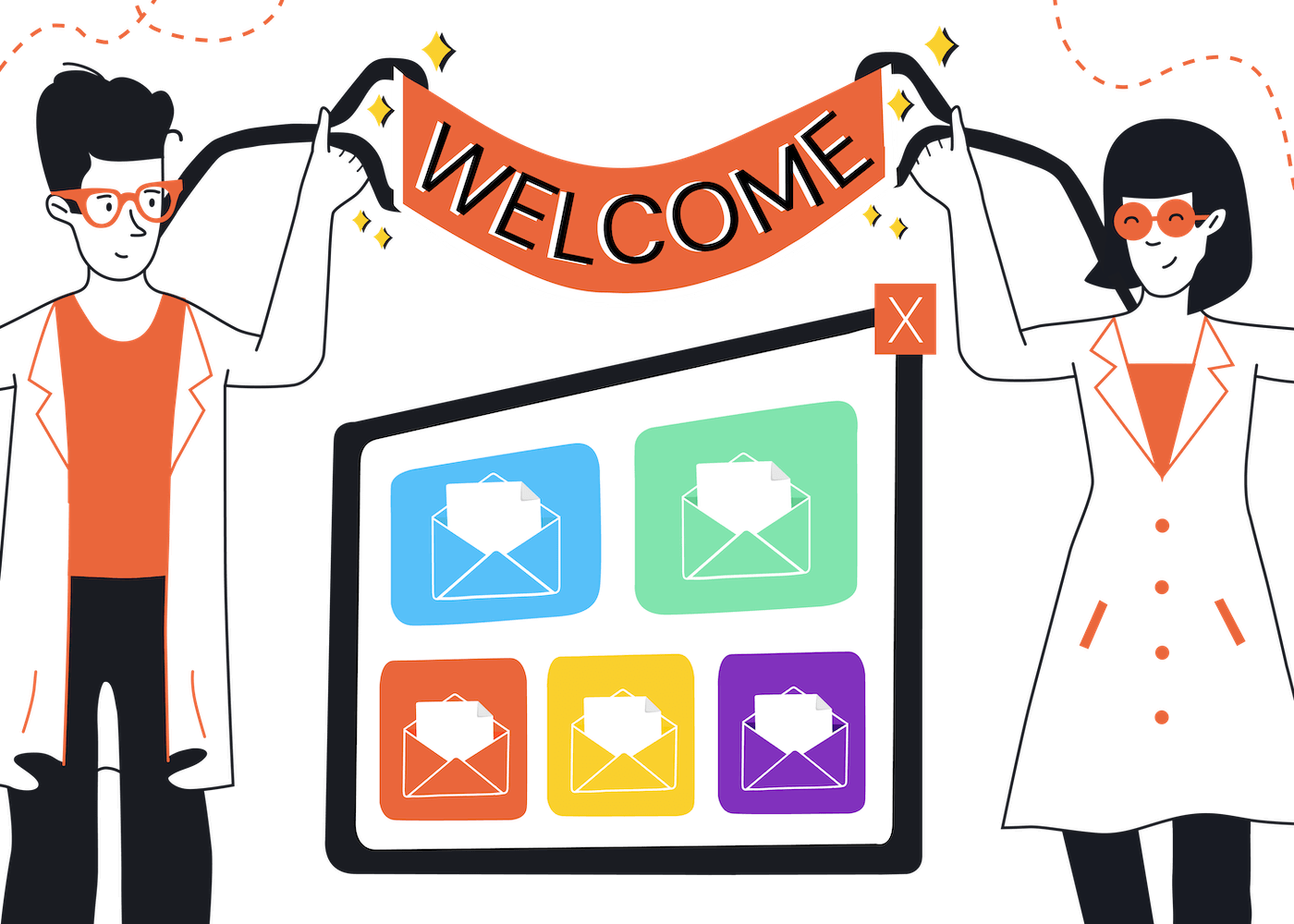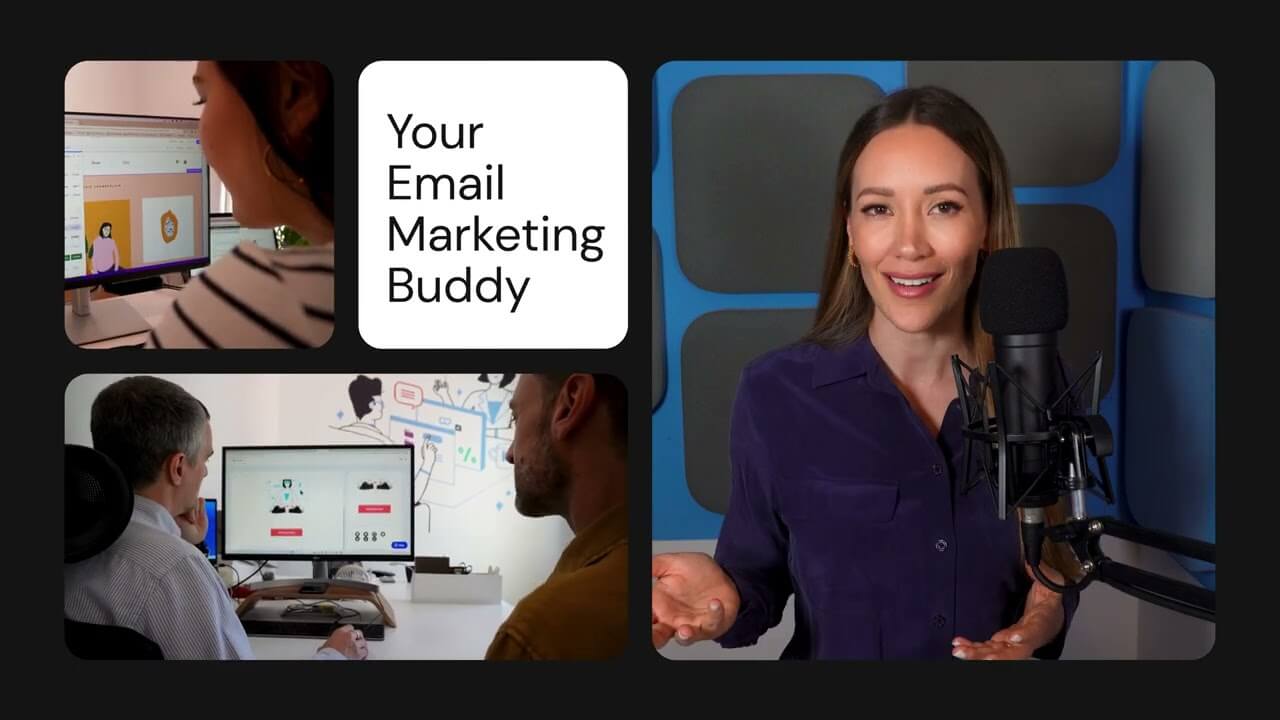EmailTooltester is supported by readers like yourself. We may earn a commission when you purchase through our links. Of course, this won't increase the cost for you.
Sending a welcome email is email marketing 101. Nearly every business sends one, and for good reason.
Welcome emails get 4x higher open rates and 5x clickthrough rates than regular campaigns, according to Mailmodo. Plus, 74% of new subscribers expect to receive one when they join a list.
But, if your welcome email stops at “Thanks for subscribing, here’s a bit about us” or simply delivers a freebie or discount code, you’re leaving your best opportunity untapped.
Because a single email can’t build a relationship. It can’t build anticipation, trust, or the kind of familiarity that makes someone want to hear from you again.
And that's why you need a welcome email series – a sequence of emails that keeps new subscribers opening, clicking, and saying yes.
In this guide, you'll learn everything you need to know about creating and setting up a welcome email series that turns subscribers' interest into ongoing engagement.
Ready to go beyond “thanks for joining”?
Let’s begin with the basics: what’s a welcome email series, and why is it important?
What is an Email Welcome Series?
A welcome email series is an automated sequence of emails sent to new subscribers or prospective customers right after they join your email list, whether through a newsletter subscription, freebie download, discount offer, or even free trial sign-up.
Think of it as a “mini-onboarding” experience. Unlike a single welcome email, a series allows you to do more than just say “welcome.” Each email in the sequence helps turn subscribers’ initial interest into a strong connection that leads to conversion.
Why Your Email Welcome Series is Important
When a subscriber joins your email list, their interest is at its peak. Curiosity is high and engagement is (almost) guaranteed. But that window doesn’t last long.
A welcome email series helps you make the most of that attention. It’s a strategic way to turn new leads into engaged subscribers and prime them to become customers.
Here are reasons your email welcome series is important:
It builds trust early
You have a tiny window to move from stranger to someone worth listening to. A welcome email series shows subscribers they’re in the right place and positions you as the expert they’ve been looking for. It builds trust early and gives them a reason to stay engaged.
It drives engagement
Welcome emails outperform every other campaign type because subscribers expect them. But if they only hear from you once, they forget you exist. Every email in a welcome series is a touchpoint that increases engagement and builds a relationship with subscribers.
It increases conversions
A welcome email series nurtures new subscribers to take a conversion action. It addresses their problems, delivers value, and overcomes their objections. By the time you invite them to take action, they’re primed and ready to say “yes.”
Email Welcome Series Best Practices
Creating a high-converting welcome series takes more than sending a few automated emails. It requires strategy, execution, and optimization. Follow these best practices to build trust, increase engagement, and drive conversions.
1. Strategy: Get the foundation right
Before you create your welcome email series, you must know why you’re sending each email and what you want it to achieve.
Identify the trigger event
How would subscribers join your email list? Is it through a newsletter opt-in form or a lead magnet? If it’s a lead magnet, what type of lead magnet is it?
The trigger event tells you why they joined, which tells you what they want next. This helps you map the welcome journey to meet their needs and avoid a one-size-fits-all welcome flow that feels robotic.
Set a clear goal for your series
Is your goal to educate? Drive first purchases? Consultation bookings? Free trial activation? Your welcome sequence should move subscribers to take action, not just introduce your business.
Make plans for segmentation
Don’t wait to figure out who subscribers are later. Make a plan for them to raise their hands (self-segment) either on the opt-in form or in the first email. This helps you send personalized and targeted emails to each subscriber.
2. Execution: Design and deliver with intention
Even the best strategy fails without strong execution. Set up your welcome series right to make sure it lands.
Perfect your timing
Send the first email immediately after signup when interest is at its highest. Then, automate the rest of the email sequence without bombarding their inbox. You can send the emails daily, every other day, or space them strategically based on engagement or behavior.
Keep your tone human
Although your welcome sequence is automated, it shouldn’t sound like an automated notification. Make sure your email copy is conversational and engaging. And personalize the emails based on subscribers’ preferences, so it feels like it was written specifically for them.
Design for clarity
Clarity > design. Your design shouldn’t make it difficult to understand your message. Use a clean layout, short paragraphs, and one clear CTA per message. Many ecommerce businesses make the mistake of creating beautiful but unclear email designs.
3. Optimization: Test, learn, and improve
A high-performing welcome email series isn’t “set and forget.” Continuously test, tweak, and improve your sequence based on performance data.
Test email elements
Small changes can have a big impact. Test different email styles, structures, and lengths. Start small with A/B testing your subject lines and CTA to see what resonates best with subscribers.
Track engagement metrics
Pay attention to open rates, clicks, and conversions over time. If engagement drops after a certain email, that’s your cue to revisit the content or timing. Also, revisit your flow regularly to make sure everything is working well.
Automate based on behavior
Go beyond static sequences. Trigger specific emails when subscribers take (or don’t take) certain actions. These micro-automations make your series feel dynamic and personal, not one-size-fits-all.
What Emails Should be in Your Email Welcome Series?
An email welcome series is made up of at least 3-5 emails. And most businesses send the same “traditional” welcome series emails – welcome email, brand/origin story email, and offer email.
This welcome email flow isn’t “bad” – it’s simple and it works (to a point). But subscribers have experienced this flow so many times, it’s become predictable. So, subscribers vanish after grabbing your freebie, and engagement rate drops after the first (or at most the second) email.
Even more concerning, most businesses make these emails all about them rather than the subscribers’ needs. That’s why you need an audience-focused welcome series. One that mirrors your subscriber’s actual decision-making journey and builds belief.
Here’s an example audience-focused flow to consider using for your welcome email series:
- Email 1: Welcome (+ freebie delivery)
- Email 2: Identify their problem or goal
- Email 3: Show how your solution helps
- Email 4: Prove it works for people like them
- Email 5: Invite them to take the next step
The Audience-Focused Welcome Series Flow + Examples
This email welcome series flow focuses on your subscribers’ needs. It feels like a helpful conversation, not an automated marketing campaign, resulting in higher engagement and better conversion rates.
Email 1: Welcome them to your list
The first email is your first impression. Use it to deliver your freebie, if you promised one, and set expectations. Let them know what kind of emails they’ll get, how often, and how it’ll help them.
If you’re an ecommerce brand, you can make it short, sweet, and fun like the ban.do email below:
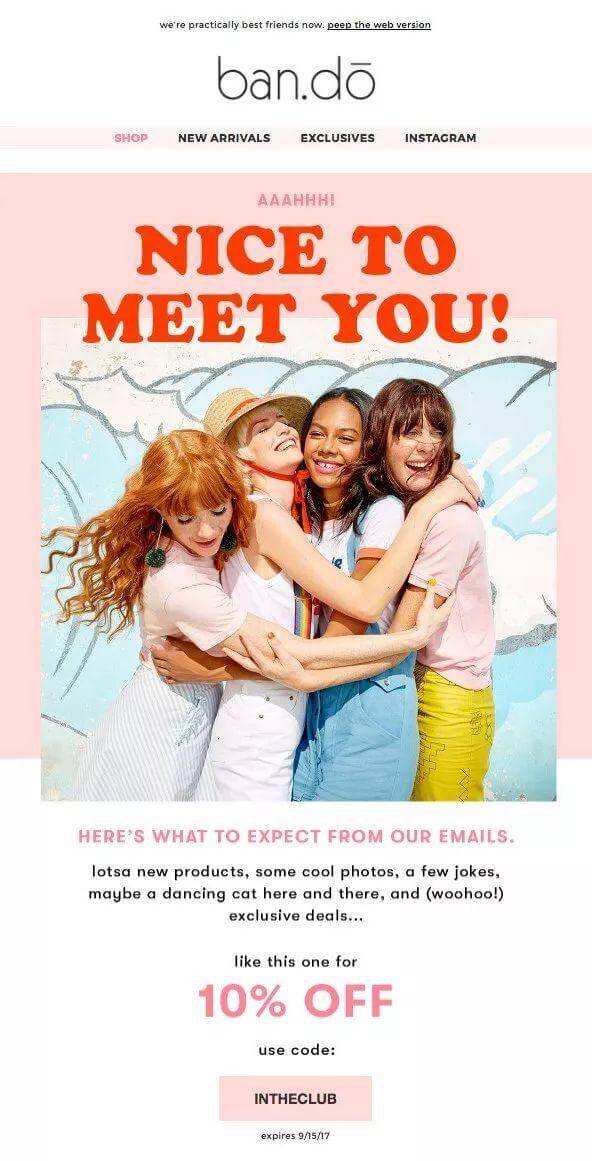
Image Source: Pinterest
Also, include interest-based prompts in the email for segmentation. For example, this welcome email from Nicolas Cole gets new subscribers to self-segment into “freelance writers” and “9-5ers.”
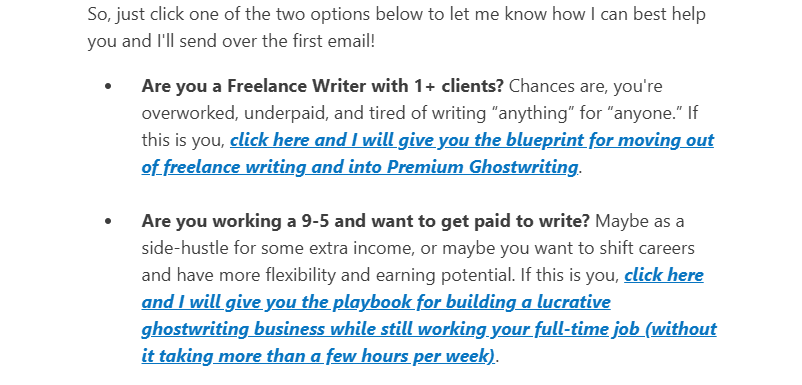
Image Source: Premium Ghostwriting Blueprint
You may also weave in your brand or origin story into your welcome email. Just make sure it’s focused on the subscriber. For example, Drift highlights in one sentence how the brand started. Then, the email transitions into how the product benefits the customer – fits into any space and is free of harsh chemicals.
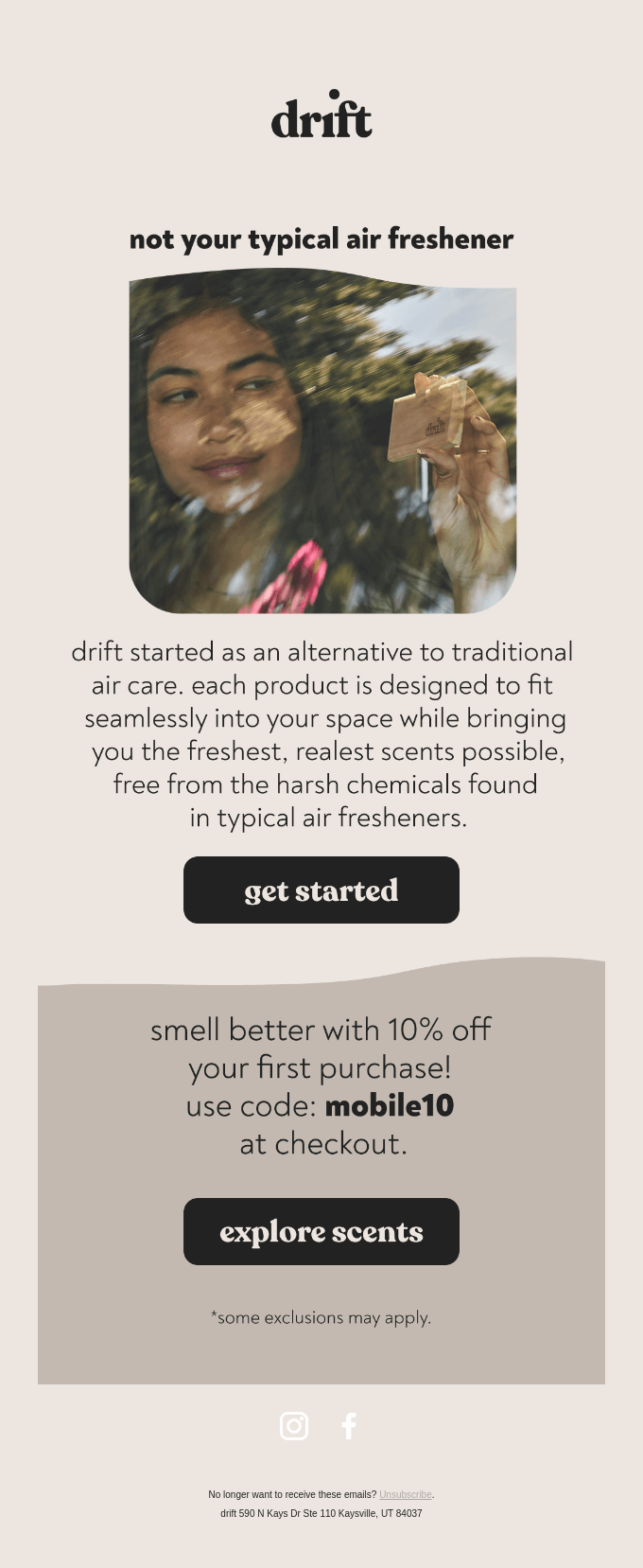
Image Source: Really Good Emails
Email 2: Address their problem or goal
What’s the real reason they joined your list? Address the problem, pain point, or goal that made them grab your freebie, sign up for a discount, start a free trial, etc. This shows new subscribers that you get them, and makes them engage.
The email can be as short as this Blaze AI email, which highlights the subscriber's aspirational goal (i.e., get their marketing assets done faster) and prompts them to take action with Blaze.

Image Source: Really Good Emails
Also, make sure to connect the problem to your solution. You can do this with a single line/paragraph. Or, use a demo or a walkthrough video like Lulu did below.

Image Source: Really Good Emails
Email 3: Show how your solution helps
What does life look like after using your solution? Use simple storytelling or product visuals to paint the transformation and build desire for your product or service.
If you run an ecommerce business, show them what changes if they use the discount code to buy your product. For freebie subscribers, use this email to expand on the value you already shared. For SaaS businesses, use a demo or walkthrough video.
For example, Coda does this with tile images showing how the tool helps subscribers make clear decisions.
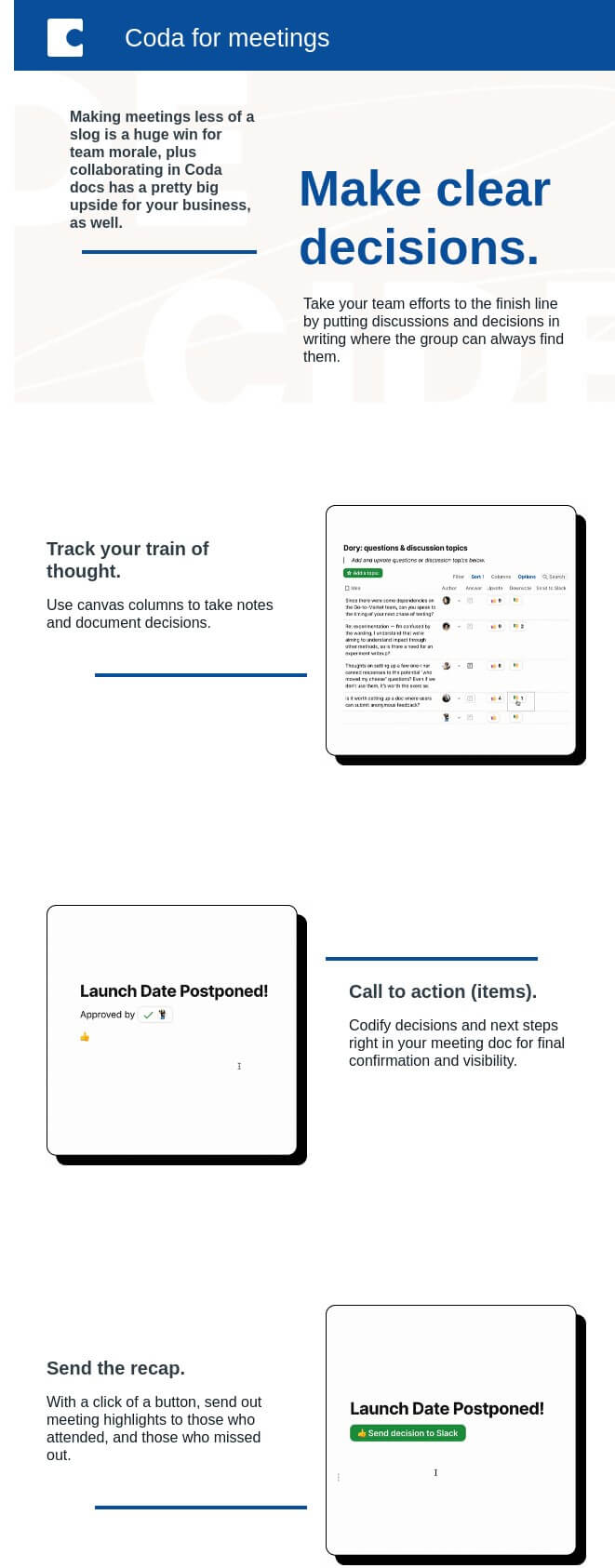
Image Source: Really Good Emails
Email 4: Prove it works for people like them
Once subscribers are presented with a solution, skepticism shows up. They'll naturally start thinking it wouldn’t work for them for one reason or the other. Use this email to share customer stories, testimonials, and transformations that match their situation.
Keep it real, visual, and outcome-focused. Asystem does this well by sharing product-specific testimonials so subscribers can click through to the products that suit their needs.
 |
|---|
Image Source: Really Good Emails
Also, proof doesn’t have to be from customer experiences. You can show customers that your product or service will work for them by sharing the unique ingredients, process, or mechanism that makes it work.
Buoy does this by breaking down the bioactive ingredients in their product, alongside testimonials that prove it’s beneficial.
 |
|---|
Image Source: Really Good Emails
Email 5: Invite them to take the next step
Now that you’ve built engagement and trust, make your ask. This may be an offer or an action you want them to take. The goal is to turn interest into conversion, without losing the trust you’ve built.
If you’re an ecommerce brand, that might be an upsell or cross-sell. Or, it might be a list of products that suit subscribers' needs, like Bellroy does in the offer (+ proof) email below.
 |
|---|
Image Source: Really Good Emails
For creators, it might be a discount offer for a premium course. While for a SaaS business, a limited-time discount or free upgrade. An example is this 30-day free offer from Linktree.

Image Source: Really Good Emails
Want more welcome email examples?
Check out our compilation of 30+ clever welcome email ideas from real brands.
Tools to Create Your Welcome Email Series
You don’t need an expensive, enterprise-level software to set up your welcome email sequence. But the right ESP can make all the difference between a disjointed setup and a seamless, automated flow.
Here are the top options worth considering, depending on your business and budget:
Brevo (formerly Sendinblue) — For Small Businesses
Brevo is a simple, affordable option that doesn’t compromise on features. It’s a smart pick if you’re just starting out. (Check out our Free Brevo Course for Beginners and get 50% off your first 3 months of Brevo Pro)
With Brevo, you get visual workflow, segmentation, and even SMS integration. Plus, its automation builder is intuitive, making it easy to create multi-step welcome sequences, even if you’re new to email marketing.
Learn More: Step-by-Step Brevo Tutorial
Klaviyo – For Ecommerce Brands
If you run an online store, then Klaviyo is built specifically for you. It integrates directly with Shopify, WooCommerce, and other ecommerce platforms, giving you instant access to customer data like browsing behavior and purchase history.
That means you can personalize your welcome emails beyond just the first name. You can send follow-ups called Flows based on the products subscribers were viewing before signing up.
Think: “Welcome, [first name]. Here’s 10% off your first order of [product they viewed].”
Learn More: Ultimate Klaviyo Tutorial
MailerLite — For Creators & Solopreneurs
MailerLite hits the sweet spot between simplicity and sophistication. It’s perfect for creators, coaches, and small businesses who want to send beautifully designed welcome emails without needing technical skills.
You can easily tag subscribers based on how they joined your list (like a lead magnet, newsletter, or product signup) or the links they click in your emails. Then, tailor the welcome emails they receive accordingly.
Learn More: Quick Guide to MailerLite
Kit (formerly ConvertKit) — For Creators & Personal Brands
Kit is designed to help you nurture relationships with subscribers (and other creators). It’s perfect if you’re running a newsletter or selling digital courses and memberships.
You can set up automated paths based on behavior, and deliver welcome emails in a natural, conversational flow. Plus, other creators can refer their subscribers to join your email list.
Learn More: ConvertKit Review
Common Welcome Email Series Mistakes to Avoid
A welcome series can be a powerful conversion asset, but only if you create and set it up right. Avoiding these mistakes helps ensure your welcome emails feel relevant, thoughtful, and worth engaging.
1. Making the email sequence about you: When your emails are all about you, people tune out. If they don’t see themselves in your emails, they won’t engage, trust, or convert.
Fix: Lead with subscribers' needs, and connect every email to helping them solve their problems or reach their goals.
2. Treating all subscribers the same: Subscribers enter your list through different paths and with different motivations. One welcome email series for everyone means the experience won’t fit anyone.
Fix: Set up variations of welcome emails based on trigger element, preferences, and behavior.
3. Bombarding them with pitches: When your emails are all about selling your products or services, trust evaporates. Your audience barely knows you yet. Bombarding them with pitches right after they join your list is a huge turn-off.
Fix: Engage and build a relationship with subscribers. Present the offer only after you’ve established rapport and trust.
4. Overstuffing every email: Your welcome series shouldn’t read like a mini ebook. Long paragraphs, multiple CTAs, and too many ideas kill attention.
Fix: Each email should have one main idea. And ask subscribers to take only one step to move forward in their journey.
5. Setting and forgetting: Neglected email welcome series become irrelevant. Offers change. Links break. Messaging evolves.
Fix: Review your sequence quarterly to update the copy, refresh links, and test your timing. You may even change or optimize your strategy based on performance data.
Final Thoughts: Email Welcome Series Best Practices
Your welcome email series isn’t just a set of automated messages. It’s the first step in building a long-term relationship with your subscribers. One that determines whether they’ll open your next email, click your CTA links, or quietly unsubscribe.
So, no matter which ESP you choose, plan and design your welcome flow around your audience's needs. Because each email is a chance to engage, earn trust, and create a lasting connection.
Also, remember not to just “set and forget it.” Review your analytics regularly to understand what resonates with your audience. The more you test and iterate, the better your email welcome series will perform.
And if you’re still figuring out which platform fits your goals best, check out our video for choosing the best email marketing tools:
Or, book an expert consultation to find the perfect match for your business
Our Methodology
This article has been written and researched following our EmailTooltester methodology.
Our Methodology